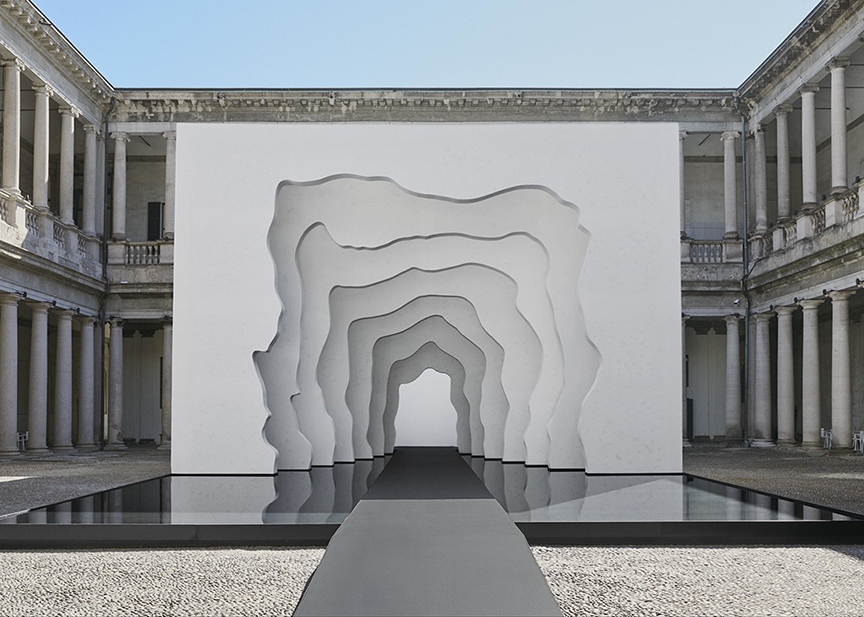The Great Escape
If you remember only one thing from Milan Design Week, let it be this: Reality is so overrated.
If you find yourself dreaming of ways to escape lately, you are not alone. Last month, Milan Design Week offered a multitude of experiences to transport our minds and spirits, without having to leave our homes. Layers that hide as much as they reveal or that distort as much as they delineate; Floral fantasies that explode on walls, opening us to a different world; Even the comfort of an oversized sofa is enhanced by the peaceful purr of a feline friend (imagined or otherwise). It was all there, revealing a cultural attitude that will guide home décor in the years ahead.
Fantastic Beasts (and Where to Find Them)
There has been a bit of buzz about the growing use of surrealism in home décor. I am hesitant to use this term only because it has a very specific meaning in the art world, first defined by André Breton in his Manifesto of Surrealism in 1924 (it should be noted that the term was first used by French poet Guillaume Apollinaire in 1917). Breton described the movement as depicting a kind of super-reality, achieved by resolving the contradictory states of dream and wake. In short, to Breton and his followers, surrealism is not fantasy—it is absolute realism.
While some of today’s design does reflect a dream-like mood and/or a warped aesthetic influenced by artists like Salvador Dalí, most of it reflects fantasies meant to be used for escapism or transcendence. Though one could argue that the floral-on-floral-on-floral installations and imagery of “Les Jardins Imaginaires” by Simone Guidarelli and Officinarkitettura reflect this kind of hyper-reality, the very title suggests an imagined fantasy. Even the brand described the installation as “a calm space where it is possible to escape from reality and reinvent oneself.”
Moooi and LG OLED presented a similar immersive fantasy in their A Life Extraordinary, with online and IRL portals aimed to transport you to “ultra-sensorial and otherworldly places.” To make the physical display even more dopamine-inducing, the installation paired home, tech, and sound systems with a scent diffusing robot named Piro. Online, A Life Extraordinary allows people to view the products and moods through an AR experience suggesting the effects the metaverse is already having on design aesthetics. In fact, even the in-situ installations feel as though you walked into the metaverse.
This continued blending of physical and digital worlds allows designers to offer a new kind of escapism—one that might be a little closer to home. While I’ve written before about the pixelation of the physical, the distorted look of glitch art is already seeping into fashion and design. Take, for instance, the digital rain of code from the Matrix, which creates an ideal, glitchy-but-not-too-glitchy aesthetic for home décor. Lee Broom’s Hail light is one example, as is Studio Terre’s curtain of Murano glass beads at Alcova.
Beyond immersive installations and virtual escapes, Milan showcased fantastical creations with other-worldly proportions. Moving beyond the neotenic, oversized and overstuffed furniture has progressed toward the absurd. Atelier Biagetti’s Pet Therapy gave a whole new meaning to the concept of pet furniture, while Paola Lenti and the Campana Brothers presented large-scale, beast-like creatures in their Metamorphisis collection.
Reality Bites
Escapism walks hand-in-hand with today’s neo-romantic era. Ethereal layers and perforation playfully conceal as much as they reveal. Translucent materials, dichromic and iridescent surfaces, and even warped reflections all blur reality to create dream-like, fantasy, and/or distorted views.
Layers do not always need to be transparent to be part of this movement. Layering can invite people into the unknown, as Daniel Arsham’s Divided Layers did at Kohler. They can also exclude the external by pinpointing our focus, as with the rugs by Mae Engeleer for CC-Tapis or Sabine Marcelis’ archway for SolidNature at Alcova. Layers also create stripes, and stripes can create illusions, like the optical effect of Chiara Andreatti’s Primitive Weave 2 carpet or the mesmerizing walls by Studio Luca Guadagnino.
Lastly, layered shapes and colors assembled in collage-like patterns or pieced together like quilts also reflect fantasy. Though not as obvious as other examples, the very act of piecing is also an act of select exclusion, choosing one element over another. Artists often employ collage to create surreal-like images. Today, these assembled elements are more Miro than Magritte, but let us not forget that Joan Miro’s “dream paintings” combined elements of both abstraction and surrealism. Textiles and rugs with blocked shapes and colors were all over Salone, as were pieced-together three-dimensional work like Pettersen & Hein’s Off-Cut chair or Linde Freya Tangelder’s Soft Corners collection.
Milan’s 2022 events offered a glimpse into the cultural attitudes that will drive design in the years ahead. While there are many micro-trends that will define this year (color: red; material: stone; style: maximalist), it is the macro movements that define the era. They express the overall cultural attitudes and values that drive the different trends. Smart brands understand that the best way to prepare for the future is to be ahead of it.

















